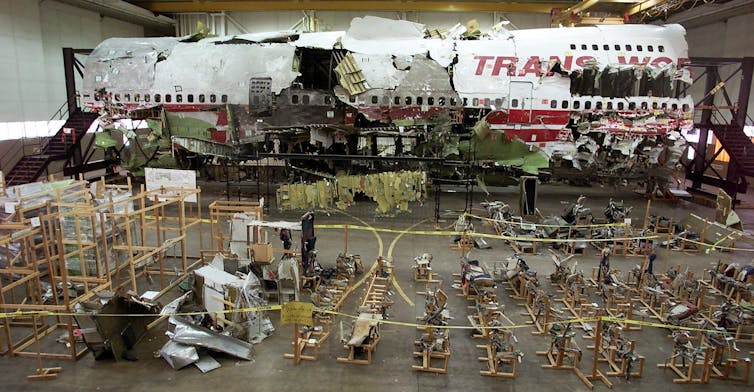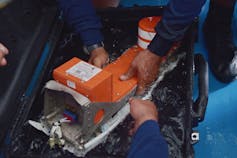Here's how airplane crash investigations work, according to an aviation safety expert
The inquiries can take months of painstaking work, but often yield important insights that improve flight safety for everyone long into the future.
The fatal crash of Ethiopian Airlines Flight 302 has resulted in the worldwide grounding of Boeing 737 Max aircraft. Investigators are probing the crash and another like it that occurred less than five months earlier in Indonesia.
As an experienced airline pilot, aircraft accident investigator and professor of aviation, I know that such major crash investigations are an enormous effort often involving many countries’ governments and input from dozens of industry partners. The inquiries can take months of painstaking work. They often yield important insights that improve flight safety for everyone long into the future. Here’s how an investigation generally goes.
A massive collaboration
The accident investigation process is laid out by the standards and recommended practices in an international agreement called Annex 13 of the Convention on International Civil Aviation. That document outlines the process of gathering and analyzing information and drawing conclusions – including determining the causes of a crash and making safety recommendations.
The government of the country where the crash occurred takes the lead in the investigation. Also involved are investigators from the countries where the aircraft is registered, where the airline’s headquarters is, where the aircraft designer is based and where the aircraft was assembled. Countries where the engines or other major aircraft components were designed and assembled and those with citizens killed or seriously injured in the crash may also take part in the investigations.
The Ethiopian Airlines crash is under investigation by Ethiopian authorities, with the assistance of members of the U.S. National Transportation Safety Board. Other countries – including Kenya, France, Canada, China, Italy and the U.K., which all lost several citizens in the crash – may ask to be part of the process.
Ethiopian investigators can seek technical advice not only from participating countries’ representatives, such as the NTSB, but also from the companies that made the plane and its engines – in this case, Boeing and CFM international, respectively.
From emergency to inquiry
At the beginning of the inquiry, the investigator-in-charge, usually an investigator from the lead country’s aviation safety board, coordinates with local first responders to determine what hazards may be present at the crash site, and ensures safe access for investigators to visit the wreckage. Dangerous debris could include hazardous cargo, flammable or toxic materials and gases, sharp or heavy objects and pressurized equipment. Human remains or blood from injured victims may also pose dangers of disease, meaning investigators must protect themselves against viruses, bacteria or parasites.
The investigators on the scene take photos and videos of the wreckage and collect as much physical evidence as they can. They also conduct interviews with eyewitnesses and draw charts showing the debris field and any indications of how the aircraft hit the ground, such as the angle of impact, the distribution of debris and other details.
If parts of aircraft can be salvaged, they can be moved to a secure facility such as a hangar for wreckage reassembling. This can assist in determining missing or damaged components, and gaining a fuller idea of what happened.
Investigators also collect all the documents related the plane, its crew and its recent flights for forensic analysis.

An early priority is locating the crucial evidence in what are often called the plane’s “black boxes.” There are two kinds. The flight data recorders keep track of flight parameters such altitude, heading, instrument readings, power settings and flight control inputs. The cockpit voice recorders store all communications with the aircraft, including from air traffic controllers, and record any conversations among cockpit occupants and other audible cockpit sounds for the two hours leading up to the crash. All that information lets analysts reconstruct, and even create video simulations of, the last moments of the plane’s flight.
If either of those devices is damaged, authorities may ask the aircraft’s manufacturer to verify the salvaged data. Ethiopian investigators have asked for foreign help to analyze the black-box data. They originally asked Germany’s Federal Bureau of Aircraft Accident Investigation, but that agency said it didn’t have the technical know-how either. France’s Bureau of Enquiry and Analysis for Civil Aviation Safety, one of the most experienced crash investigation agencies in the world, is handling them instead.

In the early stages of an investigation, there are a lot of people working on different aspects of the inquiry all at once. As the preliminary lead accident investigator for the Ghanaian MI-17 helicopter crash in Adukrom, Ghana, in January 2007, I had to coordinate the securing of the crash site and do field interviews of witnesses while charting the debris and recovering the “black box” for further analysis.
Technical groups assemble
Other teams look at technical aspects that might have contributed in any way to the crash. They look at air traffic control activity and instructions, weather, human performance issues like crew experience and training, maintenance records, emergency response, safety equipment, aircraft performance and subsystems.
They may disassemble the crashed plane’s engines or other components and use flight simulators to attempt to experience what the pilots were dealing with. Analysts even study the metals used to make components to see how they should perform – to later compare that information with what actually happened during the crash.
A team also interviews any survivors, rescue personnel and subject-matter experts. Forensic teams and medical examiners will analyze victims’ remains to identify them for family members and to examine the injuries they suffered, and test for any drugs, alcohol or even carbon monoxide in their bodies that might have impaired their judgment or performance.
In some cases, especially high-profile crashes, investigators will hold public hearings, at which they gather more evidence and make public some of what they have found. This helps assure the public that the process is open and transparent, and is not covering up the responsibility of any guilty party.
Findings and conclusions
After they rigorously analyze all the data, devise, test and evaluate different hypotheses for what could have happened, the investigative team must determine causes and contributing factors. The goal is to identify anything – acts someone did (or didn’t) do, properties of a materials, gusts of wind, and so on – that had any role in the crash.
The report should include both immediate causes – such as active failures of pilots or maintenance crew – and underlying reasons, like insufficient training or pressure to rush through a task.
Within 30 days after the crash, the investigation team must release a preliminary report to the International Civil Aviation Organization, the U.N.-related global agency overseeing commercial air travel. A final report is normally expected to follow before a year has passed. In cases where a final report can’t be issued on that timeline, the team should release an interim report on each anniversary of the event, detailing the progress so far.
Improving safety
At any point during the investigation, investigators can recommend any preventative action that it has identified as necessary to improve flight safety. In the wake of the Lion Air crash, Boeing was reportedly working on a fix to a software system, but it didn’t get released before the Ethiopian Airlines crash.
The final report, including all the safety recommendations, is released by the country that conducted the investigation to the public and is aimed at improving aviation safety and not to apportion blame.
Daniel Kwasi Adjekum is affiliated with Flight Safety Foundation, Aircraft Owners Pilots Association (AOPA), Board of Certified Safety Professionals, Ghana Air Force, Ministry of Aviation Ghana, University Aviation Association (UAA), and Association of Ghanaian Professional Pilots. I am also the consultant for AeroProSafe Consult, a private aviation safety consultancy in Grand Forks, North Dakota, U.S.
Read These Next
As DOJ begins to release Epstein files, his many victims deserve more attention than the powerful me
Powerful men connected to Jeffrey Epstein are named, dissected and speculated about. The survivors,…
People are getting their news from AI – and it’s altering their views
Even when information is factually accurate, how it’s presented can introduce subtle biases. As large…
RFK Jr. wants to scrutinize the vaccine schedule – but its safety record is already decades long
Federal officials are questioning the safety of the vaccine series children receive. Here’s the story…






